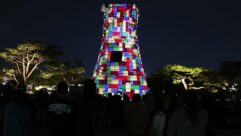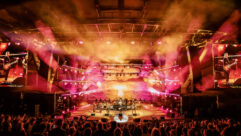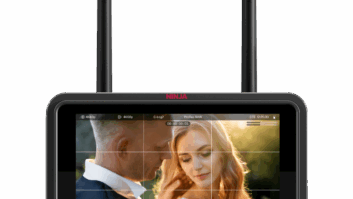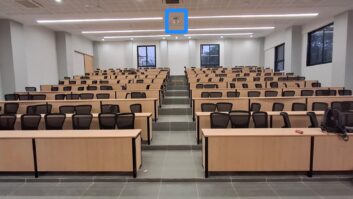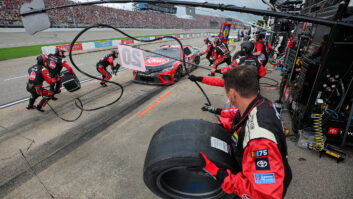All That Was Promised
Mar 1, 1996 12:00 PM,
By Keith Clark
When a venue is used for more purposes than one, it often serves only one of those purposes well; the others are treated rather like poor relations. That is not the case with the new Rose Garden Arena in downtown Portland, OR. Home of the NBA’s Portland Trail Blazers, it’s designed primarily for basketball, but it also hosts minor-league hockey and concerts. A careful sound-system and acoustic design features a number of notable aspects that ensure quality sound for sports and music.
The Rose Garden offers a much larger seating capacity than its predecessor, which sits adjacent to the new building. The Rose Garden includes three primary levels of seating: an upper level, a lower level and a VIP-suite section sandwiched in between. The shape of the 19,500-seat arena is oval, with seating completely surrounding the main-floor playing surface.
The Oregon Arena Corporation (OAC) was formed to oversee the Rose Garden project. Paul Allen, cofounder of Microsoft, is the building’s primary owner, and he also owns the Trail Blazers. Both Allen and the OAC played active roles in the facility’s development.
Wrightson, Johnson, Haddon & Williams (WJHW) of Dallas provided the stadium’s acoustic and sound-system designs, with Jack Wrightson handling the acoustic side. Ron Baker, senior associate, headed sound-system design efforts. Installation and extra customization services were supplied by AAtronics of Boise, ID, and Portland, OR.
Impact and effect”Acoustically, the Rose Garden includes more unique aspects than many other recent arena pro-jects we’ve been involved with,” said Baker.
In the proposal stage, WJHW supplied acoustical room simulations demonstrating the effects various acoustic treatments would have. The objective was to develop treatments that would allow the acoustics to be altered for sports use instead of concert use.
For sports, the desire was for a bit more of a live ambiance, helping to retain the higher energy level generated by the crowd. For concerts, the less reflection, the better. The room modeling went a long way in explaining the specifics of these concepts and helped convince the OAC to pursue the proposal.A series of panels, which WJHW called clouds, are suspended in rows along each of the long sides of the oval. Each cloud is 10’x10′ (3mx3m), providing 100ft2 (9m2) of surface area per panel. The panels are slightly curved, with a hard side and a more absorptive side. They are rigged with motorized winches and battens that allow them to be raised, lowered and rotated with soft- or hard-side down. The clouds give the designer the flexibility to alter or change the room for each event. Panels can be mixed and matched, some hard-side down and others soft-side down, in configurations ranging from flat to a variety of stair-step arrangements.
Further acoustic enhancement is provided by Tectum treatments applied to the surface of the large walls immediately behind the upper seating level. The back side of an eyebrow overhang at the ceiling level is covered with insulation to trap stray energy that might reflect between it and the ceiling. Padded seats further lower reverb.”All of these elements combine to make the room quite well behaved for a large arena,” Baker said.
Proactive approachThe building owner and management staff took a proactive role in the selection of the loudspeakers to be used in the Rose Garden’s main sound-reinforcement system. They attended a National Systems Contractors Association (NSCA) expo, interviewed prospective manufacturers and conducted their own comparison of several brands.
Based upon this research, four leading manufacturers were invited to participate in a live demonstration of their products. Each company was given a set of basic guidelines outlining the type of coverage desired and the preferred type of cabinet. A panel made up of staff members then evaluated each demo. Eastern Acoustic Works (EAW) loudspeakers were judged to best meet all criteria.
Before this evaluation phase, WJHW had already specified a basic configuration for the main loudspeakers. This design called for what they call an exploded cluster: four individual clusters flown just outside and above each face of the centrally located main scoreboard. The exploded cluster works because it doesn’t conflict with the scoreboard’s ability to move up and down, as a true central cluster would. The exploded cluster provides four clusters with overlap zones.
Each cluster is individually rigged on a cable-and-drum type of winch, so each cluster can be individually lowered to the floor for maintenance or retracted for storage when not needed. Baker noted that this type of rigging is unusual in typical arena projects, where chain-motor systems are more typical. The system at the Rose Garden is a bit more expensive, but the advantage is the clusters are more easy to position.
Loudspeakers in three tiersEach of the four clusters includes three tiers of loudspeakers, covering top, middle and lower seating sections. Mid-high-frequency loudspeakers and low-frequency loudspeakers are arrayed horizontally within each tier, with longer-throw loudspeakers for upper regions and shorter-throw loudspeakers for lower regions.
Providing the longer throw, upper-tier coverage throughout the four clusters are 14 EAW MH662E loudspeakers with dual, 10-inch (254mm) cone-loaded midrange sections. Middle and lower seating sections are covered by two tiers of 18 EAW MH660E mid-high loudspeakers distributed among the four clusters.
Both the MH662E and MH660E feature the horizontal coverage control found in EAW’s Virtual Array Technology systems. In addition, their mid- and high-frequency horn mouths are larger, improving their 45ø vertical pattern control as compared to conventional designs. Tightly controlled dispersion in both planes facilitates arrays that offer high intelligibility.
Both loudspeaker models also include EAW’s unique midbass horn-displacement plug technique in the loading of the 10-inch cone drivers. The wood veneer of the midbass horns is reinforced with high-density polyurethane foam for structural rigidity and acoustical damping.
The upper tier of the four clusters includes 16 EAW BV535iP low-frequency loudspeakers, each loaded with three 15-inch (381mm) woofers in a vented enclosure. The two lower tiers’ low-frequencies are supplied by 14 EAW BV525P systems with dual 15-inch direct-radiating loudspeakers.
The vented enclosures of the EAW BV series use enclosure resonance to reinforce the driver’s own output. They can be tailored precisely to match the output characteristics of the mid-high loudspeakers, resulting in a smooth, full-range sound. The BV-series enclosure sizes and angles are optimized for use with the MH series for creation of true three-way, large-format arrays that combine effective pattern control with full-range musical response.
The last rows of the upper deck receive a delay fill provided by 26 EAW FR122P loudspeakers dead-hung from a catwalk ringing the arena. Additional coverage to the floor and seating immediately adjacent to it is supplied by four EAW AS300i compact two-way loudspeakers tucked underneath the scoreboard.
Enhanced controlAll loudspeakers are driven by QSC EX-series power amplifiers rack-mounted in a catwalk area at one end of the arena. The entire EX series is used, with EX-4000s on low frequencies, EX-2500s for midrange and EX-1250s for high frequencies. For shorter-throw, high-frequency applications, EX-800s were the choice, with EX-1600s employed for a few short-throw midrange loudspeakers.
One reason the QSC amps were selected was because of their advanced compatibility with the MediaLink control system used for this project. Fiber optics link the QSC amplifiers to MediaLink, which operates on a Macintosh computer in the system control booth more than 400 feet (122 m) away. The control system was initially intended to provide convenient main system setup, on-and-off control and monitoring of various amplifiers driving the loudspeaker cluster.
However, the contractor, AAtronics, in conjunction with MediaLink, decided the control system could be used with the arena’s numerous other sound systems in areas such as concourses and restrooms. The contractor also wanted to tie in control and monitoring of the facility’s emergency paging system.This was accomplished by using what MediaLink calls a control tap, a device serving as an interface between analog contact closures and the MediaLink software. The bidirectional device either generates a contact closure or responds to one. The various concourse and restroom subsystems were linked to the control tap, which then allows program routing and level control to be supplied directly from the host Macintosh computer. In reverse, the control tap senses a contact closure from the emergency paging system and responds by un-muting all amplifiers and providing an override for sending emergency announcements building-wide. Reverse of this contact closure returns the main system and subsystems to their prior configurations.
“AAtronics really went the extra mile in making this happen,” Baker said. “And the MediaLink system has performed in a very stable manner.”
Plenty of processingThe control booth houses a Biamp Olympia 24-input mixing console along with the usual host of source devices, including CD and cassette players and an AM-FM receiver. Monitoring is provided by a single EAW KF300i compact loudspeaker mounted about 50 feet (15m) in front of the control booth’s window.The source device of note is a Game Ops Commander, a product developed and marketed by Asymmetrix, another of Allen’s holdings. It includes Windows-type software loaded on a DOS computer that allows immediate point-and-click access to a huge library of songs and a variety of sound effects perfect for use with basketball games.
More convenient system operation will be provided by the Game Ops Commander, particularly in combination with a Lintek crowd compensation unit. It tracks and adjusts the sound system in relation to crowd noise, so a single operator isn’t required to constantly ride the gain of the main system.The control booth also hosts a variety of signal-processing devices. Signal to the main system is first routed to an Aphex Systems 720 Dominator II, a stereo multiband peak limiter that is virtually transparent.
“The Aphex Dominator was selected instead of more conventional devices because it does peak limiting in specific bands instead of just offering broad-range sensing capability,” Baker said.With the use of specialized proprietary circuits and multiband techniques, audibility of limiting action is notably reduced and greater limiting depth provided, resulting in higher overall loudness with maintained audio quality.
An Apogee CRQ-12 provides overall system EQ; individual White DSP5000 processors are dedicated to each cluster’s upper and lower sections. The DSP5000s offer crossover as well as three bands of parametric filters for custom spectral tailoring. The delay of the DSP5000s smooth out overlap areas between the adjacent clusters.
Delay and band limiting for select subsystems and the loudspeakers beneath the scoreboard are provided by Peavey CEX4LA processors. Concourse systems are on four separate delay zones, per floor, to keep them in approximate synchronization with sound from the main system shooting out of portals and entry ways.
Rane GE30 and GE60 1/3-octave EQs are also used with most subsystems, with parametric EQ on a couple of these systems supplied by Rane PE17s. According to Baker, he has gone to more parametric equalization because he generally uses instrumentation more suited to parametric’s more precise adjustment.
Uncommonly goodFunctionality and flexibility of the Rose Garden system and subsystems are unusually good, in large part because of MediaLink control and the commitment of the contractor to use this product to its fullest potential. In addition, the combination of several specialized elements has produced sound quality and acoustics not commonly found in most arenas.
Testing after system commission showed reverb times in the sports mode, with clouds hard-side down, to be at or under three seconds. This corresponds closely to WJHW’s predictions and indeed is exceptional for a space as large and live as the Rose Garden.



